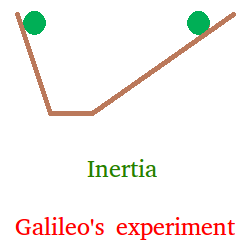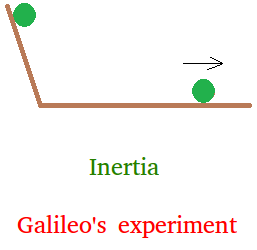Definition and Examples of Inertia
Isaac Newton is the one who formulated a great definition of inertia. Also known as Newton's first law of motion or law of inertia, Newton restated Galileo's idea. The spinning top in the video will keep spinning if there was no friction.
Below is what Newton said in simple terms:
If an object is already moving, it will keep moving in a straight line at constant speed unless a force stops it.
If an object is at rest, it will remain at rest unless a force moves it.
In other words, Newton is saying that an object will keep its uniform motion if no force tries to stop it and it will not start moving unless some external force makes it move.
This was an important discovery because Aristotle believed that if an object keeps moving, then some force is being applied to it.
Aristotle did not say that an object can start moving on its own. He believed that force must be applied to get something to move.
However, he also believed that as soon as this force is removed, the object will seek its natural state that is rest.
This view of motion was accepted for about 2000 years until Galileo challenged it with an experiment.
Galileo's Experiments on Inertia
Galileo used the two planes you see below. Then, he rolled a ball
down the incline. He noticed that the ball will continue to move until
it reaches almost the same height on the other side. The less friction
there is on the plane, or the smoother the plane is, the higher the ball
will move to reach nearly the same height.

This is interesting because when the ball reaches the bottom of the incline, there is no more gravity to keep the ball moving.
The ball thus kept its natural state of motion.
The second experiment is similar to the first one except that the
other plane is longer and the plane is inclined at a smaller angle.

The ball still nearly reached the same height, but this time traveled a longer distance.
What if the other plane was completely horizontal?

Again, in the absence of external forces such as friction or gravity, the ball will keep rolling with a constant speed.
The ball will not come to rest as Aristotle said.
Examples of Inertia in Real Life
- A great example of inertia is when somebody is not wearing a seat belt while driving. The car collides with a tree and the person flies. The body was just trying to keep the same speed before impact. Now you know why you should always put your seat belt. Inertia could kill you!
- A soccer ball keeps moving after it has been kicked.
- A sofa is not moving because no one is pushing it with a force.
- A car continues to move on an icy road even after you applied the break.
- A shopping cart is not moving because no one is pushing it.
A Solid Definition of Inertia
In the absence of forces or friction, an object already in motion will keep moving indefinitely.
An object at rest remains at rest unless a force is applied to the object.
If you are taking a physics class, your teacher may use an air table to demonstrate inertia to you and your classmates. An air table has many tiny holes where blasts of air are coming out. It does not reduce friction completely, but reduces it tremendously.